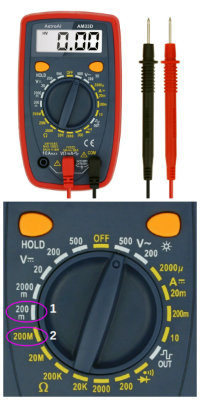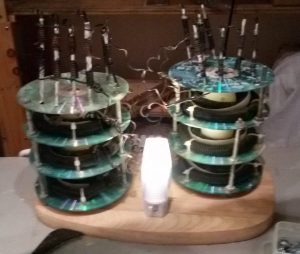Electrical particularities of nano layers
 The nano-layers show remarkable features that can be checked with a multi-meter. To do this, place the multi-meter terminals as gently as possible on the nano plated object so as not to damage the nano layers.
The nano-layers show remarkable features that can be checked with a multi-meter. To do this, place the multi-meter terminals as gently as possible on the nano plated object so as not to damage the nano layers.
 Measure the voltage
Measure the voltage
To measure the voltage, select the smallest scale in the Volt direct current range (VDC) row: 200m = 200milliVolt.
Measuring resistance![]()
To measure the resistance, select the largest scale in the Ohm range: 200M = 200 Mega-Ohm.
The conductivity of a material is inversely proportional to it’s resistance; if the measured resistance is 0, the conductivity is perfect; and when the resistance increases, the conductivity decreases.
The quality of the nano plating can be checked in two ways: you should detect a fluctuating voltage and a resistance that is greater than 1M Ohm. Here is how you do it:
- Nano layers transmit a current
- Select’VDC’
- Measure a coil or other piece of simple copper, which has not been nano coated. You do not detect any voltage and no current flows through it.
- If, on the other hand, you measure a piece of nano plated copper in the same way, you will see that the multimeter indicator indicates a fluctuating voltage (3 – 300+mV).
Where does this electrical energy come from?
- Nano layers have no electrical conductivity
- Now change the measurement range of the multimeter to resistance (Ω).
- When you measure a simple piece of copper, you will get 0 Ω; there is no resistance, i.e. the object conducts electricity well.
- Now measure a piece of nano coated copper. If the nano coating is well done, you will measure a resistance above 1 Mega-Ohm = 1,000,000 Ω
This means that the nano layers have an almost infinite resistance against an electric current. Since the resistance is inversely proportional to the conductivity, we can say that a piece of nano plated copper conducts practically no electricity.
As a nano layer has a very great resistance to electrical current, it has practically no resistance to a plasma current.
 The mystery for Mr. Ohm
The mystery for Mr. Ohm
Ohm’s law describes the relationship between voltage, current and resistance in an electrical circuit.
I=U/R
 The above formula means:
The above formula means:
Current = voltage divided by resistance
Example note: A magrav is connected to the 120VAC wall plug. The coils resistance show a resistance of 1,500,000 Ohm.
According to Ohm’s law:
120V/ 1,500,000 = 0.000 08 A = 0.08mA
Such a current is too low to light a lamp… but… oh miracle – the bulb lights up!